the robotic cyclist
aka artist trapped in artaud's cage |
| image |
details |
general commentary |
artist's running commentary |
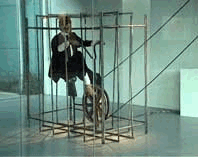 
Canberra Museum & Art Gallery (CMAG) 2002 at Sydney University 2007
|
This is possibly one of the more complex robotic works that i have created. Its lifelike appearance and actions certainly created a sensation in Canberra when it was installed into the CMAG window in December 2002.
Theatre goers emerging from the nearby Playhouse late at night would trigger the cyclist into action much to their surprise.
|
Construction and Testing
Preliminary Research
|

Click to start slide show of 3 images
click RHS of final image to return here
|
Prelininary sketches translating an idea of someone trapped and working within a cage;
reified as a robotic cyclist; a physical, viewable and working object.
|
Preliminary sketches that envisage the final installation. The initial idea of creating an automated robotic cyclist then encompassed detailed problems associated with the joints and articulation of the spine, head and legs. Movement of the spine in particular involved input from Ken Myer the electronic engineer, Russell Emmerson of the Centre for Performance Studies at Sydney University and the artist.
These sketches are worth examining in detail as they reveal interesting and imaginative solutions to these problems.
|
Background from Artaud's writings
This work started to take shape in 2001. I was particularly intrigued by the writings of Antonin Artaud. Imprisoned he sees himself as the sole free person living outside a caged encapsulated world.
extra input via Samuel Beckett
The idea of the artist trapped in a cage endlessly cycling to turn the wheel located way outside of his grasp appealed to me. Yes, there are also shades of one of Samuel Beckett's characters embedded here.
The following Artaud-like script was generated in parallel with the work.
Script associated with the “Artist Trapped in Artaud’s Cage” installation.
I know where I am going –
What I have to do.
My hands & feet are fixed to the task;
Endless micro ergs of energy
Keep the wheels turning.
But my head & body are starting to forget.
I have to keep reminding myself.
Now what was it?
the eternal existential dilemma
|

Click to start slide show of 3 images
click RHS of final image to return here
|
More detailed sketches illustrating some of the mechanical issues that needed to be solved. |
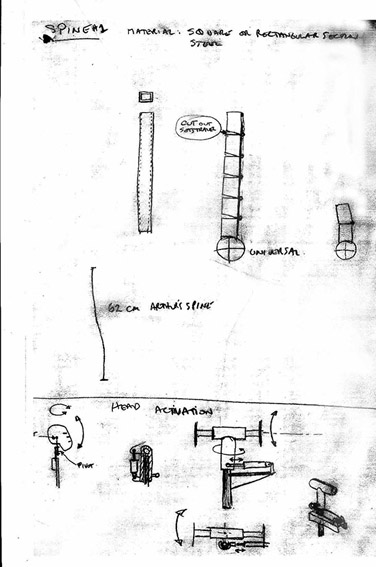
Click to start slide show of 4 images
click RHS of final image to return here
|
Mechanical solutions supplied by Russell Emerson (Performance Studies University of Sydney).
His contribution was significant in solving mechinical issues.
|
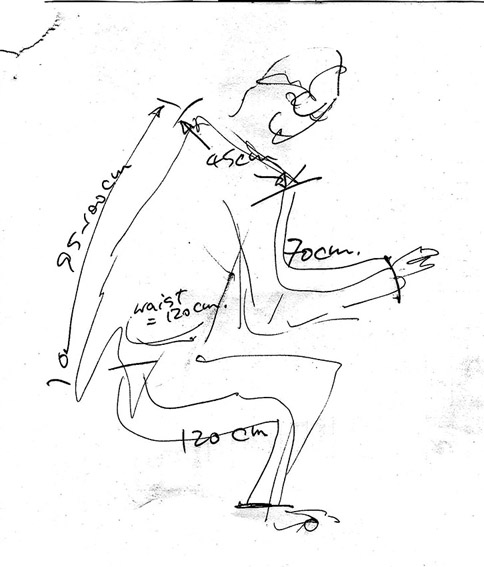
Click to start slide show of 2 images
click RHS of final image to return here |
Clothing the robot required making a special suit.
Sketches showing dimenions etc. |
Construction and Testing
the Mechanics
|

Slide show of 4 images showing how head movement is controlled
click to start
click RHS last image to return here
|
Motion of the head.
A rotating pneumatic was installed inside the skull; programmed to twist left & right 90 degrees.
A pneumatic piston was installed at the top of the spine to pull the head up & down to create the nodding motion. |
The movement of the cyclist reduced to 3 basic motions:
1. the cyclist ability to collapse over the handlebars & then to spring upright again,
2. motion of the head - to nod up and down, and to twist form side to side idependently
3. cycling action with the legs - controlled by a motor located in the far corner and attached to the large wheel by a long pulley belt (special neoprene rubber). |
|
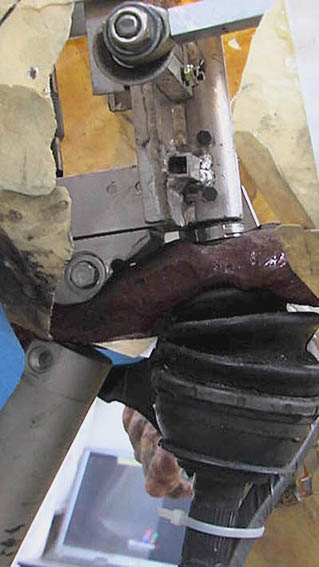
Slide show of 12 images; each shows a specific itemised detail
critical to the cyclist working
click to start
click RHS last image to return here
|
Control of the spine:
seat was welded to a Constant Velocity (CV) joint.
Spine control created the effect of the cyclist collapsing over the heandlebars and then tensing back into an upright position.
The spine was articulated with small square profile aluminium sections. Thick polycarbonate strap held these pieces in place (pop rivets). Heavy duty twisted wire attached to top of spine; lower end to heavy duty pneumatic piston. Strap & wire then controlled the tension & relaxing of the spine. |
|
|
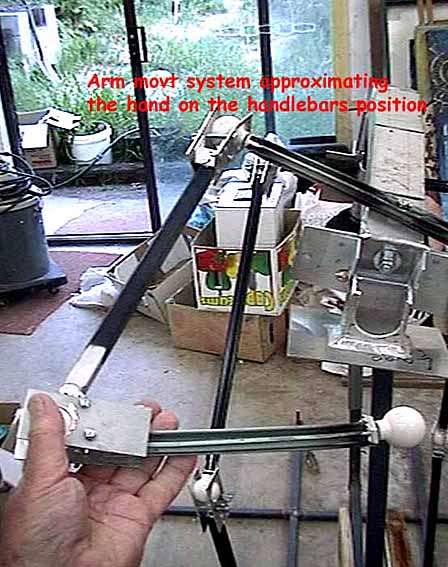
Slide show of 10 images; showing how the joints are connected & controlled
click to start
click RHS last image to return here
|
:
Jointing of limbs:
namely the elbow and wrist joints; the pelvis to leg joints; ankle to foot joint.
Small bolts used to limit the movement of arms, legs & feet to prevent these parts of the figure bending in the wrong direction and breaking
. |
|
|
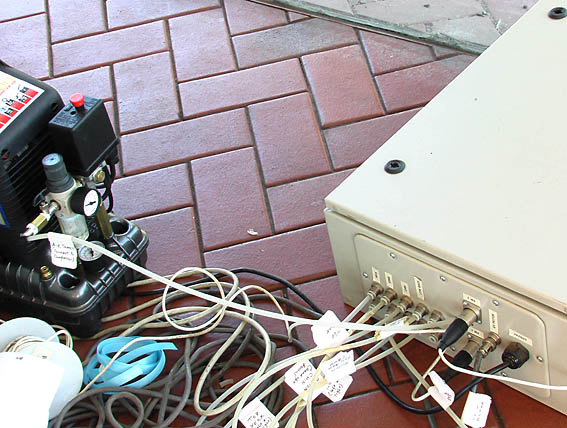
|
the Pneumatic system:
The skeletal joints have been connected; the pneumatic pistoms installed.
The air hoses, power and ancillary devices (eg PIRs) are now connected.
This is how it was prepared for the initial installation onto the CMAG 2002-2003.
|
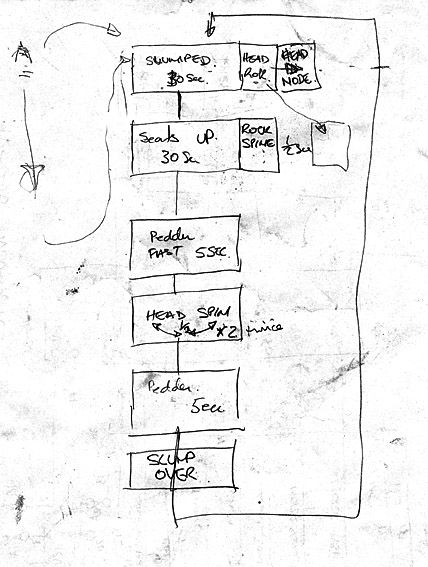
schematic showing the various actions of the cyclist that need to be programmed.
click to enlarge, then click to return here.
|

schematic showing how the electrics are connected; inputs & outputs into the PLC
click to enlarge, then click to return here. |

Slide show of 6 images showing final testing
click to start
click RHS last image to return here
|
Final Testing Stage:
Now the skeletal joints have been connected; the pneumatic pistoms installed & connected, the micro computer and software installed, the fibreglass skin sections attached;
the system is put through final testing |
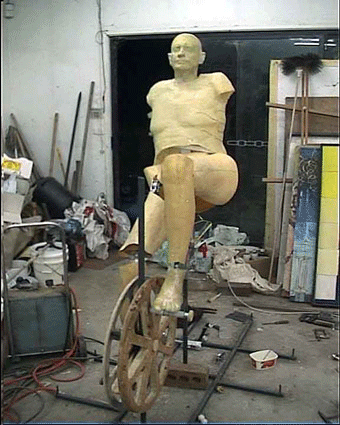 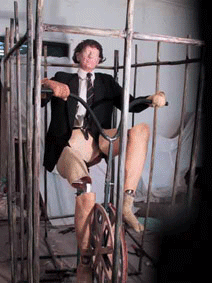
animations showing the 2 main actions of the cyclist |
Canberra Museum and Art Gallery, Canberra
December 2002 to February 2003
|
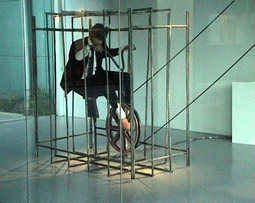
Click to enlarge.
Then click RHS to return
|
The Artist Trapped in Artaud's Cage.
Installed into the public widow space - visible 24/7 next the the Canberra Playhouse in Civic Square.
|
Script associated with the “Artist Trapped in Artaud’s Cage” installation.
I know where I am going –
What I have to do.
My hands & feet are fixed to the task;
Endless micro ergs of energy
Keep the wheels turning.
But my head & body are starting to forget.
I have to keep reminding myself.
Now what was it?
This script was written on the window facing Civic Square where passers by could easily read it. |
This robotic work was designed and created to be installed into this space at CMAG.
The Director Peter Haynes and Curator Mark van Veen were instrumental in making the installation possible.
|
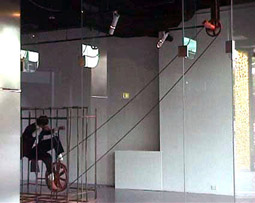
Click to enlarge.
Then click RHS to return
|
Showing the full installation: cyclist, cage and ceiling pulley wheel with extended belt. |

Click to enlarge.
Then click RHS to return
|
AMA advert No 156
Dec 2002 - Feb 2003 inside front cover |
the University of Sydney,
Easter Ave Lecture Theatre Foyer
August 2007
|
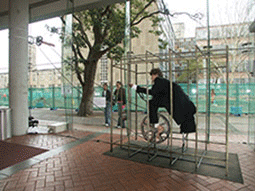
Click to enlarge.
Then click RHS to return
|
The Artist Trapped in Artaud's Cage |
This animated gif gives an idea of the various torso body movements which, when associated with the motor driving the legs provides a complex robotic animation. |
The Centre for Performance Studies at Sydney University enthusiastically made this installation possible. Russell Emerson was working there at the time and was especially helpful. Russell was involved in the initial research to ensure that the robotic elements of the work came together.
During this time, Tony Bond from the Art Gallery of NSW viewed the work and was interested in displaying it at the AGNSW should the opportunity arise.
The cyclist was then freighted to the AGNSW from the university grounds but the opportunity to display it didn't eventuate.
It stayed in storage at the AGNSW for some months. The University of Technology Sydney (UTS) expressed interest in displayin ghte work. It was then freighted there and exhibited for several months.
|
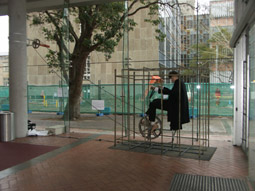
Click to enlarge.
Then click RHS to return
|
Photographs:
Russell Emerson and Arthur Wicks |
|

Click to start slide show of 7 images
click RHS of final image to return here
|
|

promotion on the Art Monthly Australia (AMA) August 2007
Click to enlarge.
Then click RHS to return |
|
|
|
|
the University of Technology Sydney,
October 2008 to February 2009
|
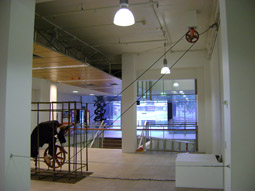
Click to enlarge.
Then click RHS to return
|
The Robotic Cyclist located in the University of Technology Sydney (UTS) in one of the foyers adjacent to Harris St.
|
|
I was unable to be present and assist installation of the work at UTS. But the staff from the science department were totally capable of assembling and activating the work without my involvement. I was very pleased that this was the case as it meant that future installations were possible at any time without my being there. The accompanying manual was probably an asset as well. |

Click to enlarge.
Then click RHS to return
|
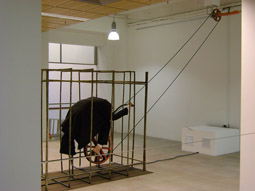
Click to enlarge.
Then click RHS to return |
|
| |
|
|
|